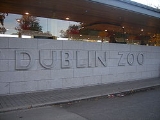
Dublin Zoo
Encyclopedia
Dublin Zoo in Phoenix Park
, Dublin, Ireland
is the largest zoo
in Ireland and one of Dublin's most popular attractions. Opened in 1831, the zoo describes its role as conservation
, study, and education. Its stated mission is to "work in partnership with zoos worldwide to make a significant contribution to the conservation of the endangered species
on Earth".
Covering over 24 hectares (59 acre) of Phoenix Park, it is divided into areas named World of Cat
s, World of Primate
s, The Kaziranga Forest Trail, Fringes of the Arctic
, African Plains, Birds, Reptile
s, Plants, City Farm and Endangered Species
.
In 2010, Dublin Zoo received 963,053 visitors.
(EEP), which helps the conservation of endangered species in Europe
. Each species supervised by the EEP has a single coordinator that is responsible for the building of breeding groups with the aim of obtaining a genetically balanced population.
Dublin Zoo manages the EEP for the Golden Lion Tamarin
and the Moluccan Cockatoo
. It also houses members of the species Goeldi’s monkey
and the white-faced Saki
which are part of EEPs coordinated by other zoos. The focus is on conservation, which includes breeding and protecting endangered species, as well as research, study and education.
are one of Dublin Zoo's endangered species. Fruit bats, as their name suggests, feed on fruit and because of that are very important to the rain forest. Bats cannot digest the seeds and pips of the fruit that they eat and so the seeds leave the bat's digestive system "wrapped" in fertilizer. Without bats, many rain forest trees would not be able to sow their own seeds.
Dublin Zoo has recently completed a larger Asian Elephant
enclosure (complete with Asian rainforest) and the Nesbit House(bat house) has been demolished. The Rodrigues fruit bats are now in the Roberts House (or bird house), which is located beside the Ring-tailed Lemur
s).
, are threatened with extinction in their natural habitat. Dublin Zoo is involved in the international breeding program and helps to fund researchers who study the Tamarins in Brazil
.
The forests that Golden Lion Tamarins need in order to survive are cut down for timber and to make room for cattle ranch
es, farm
s and urbanization
. Sometimes very small areas or 'pockets' of forest are left but these are too small for the Tamarins to survive in. In the past, Tamarins were collected for sale to the pet trade or for use in research laboratories. The Golden lion tamarins are located in the South America
n house.
for Moluccan Cockatoo
s. A studbook is a record of all the individuals of a particular species that are held in zoos in a region. It contains information such as the sex
of the animal, how old it is and who its parents were. This information is then used to decide which birds should be paired with which to get the best genetic mix
. This ensures that the captive population stays as genetically healthy as possible. Moluccan Cockatoos are handsome birds, white-with-a-hint-of-pink feathers and a pink colour on the crest. This cockatoo is on the endangered species list.
. In 1994 it was presented to Minister of Finance Bertie Ahern
. The government granted the zoo IR£
15 million (€19 million) for improvements. Themed areas were decided on and the first, World of Primates, opened to the public in 1996. The latest, African Plains, opened in 2001.
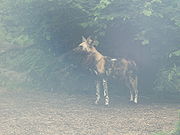
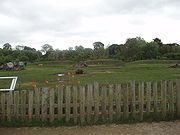


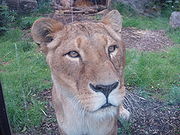

s, African Lion
s, African Wild Dog
s, Red River Hog
s, White-crowned Mangabey
s, Chimpanzee
s, White Rhinos, Hippo
s, Giraffe
s, Zebra
s, Ostrich
es, Gorilla
s and Scimitar-horned Oryx (this species is now extinct in the wild). The African Savanna
Exhibit opened in April 2009.
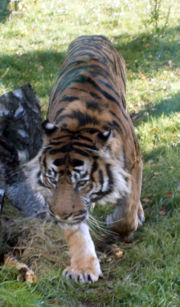
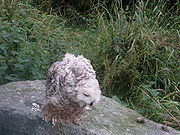
s at Dublin Zoo because the enclosure was too small for them. It was enlarged to house three Amur Tiger
s (one male and two females), the largest species of fullblood cats in the world. Amur Tigers, unlike other tiger sub-species, live in the cold north. The area also includes Grey Wolves, Arctic Fox
es, Snowy Owl
s and Humboldt Penguin
s.
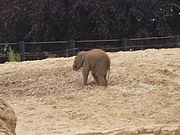
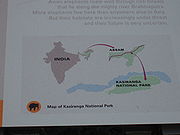

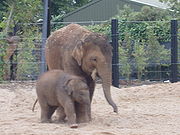

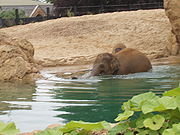


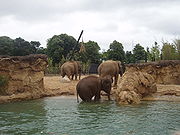

s in the zoo, Judy and Kirsty, came from Chester Zoo
in 1991, and later moved to Neunkirchen
Zoo in Germany
.
A new enclosure is being built that will be 50% bigger than the old one. Two adult females, Bernhardine and Yasmin (who are sisters), and Yasmine's calf, Anak, arrived in Dublin Zoo from Rotterdam Zoo in October 2006. They are in quarantine
and will be on view to the public in 2007.
Bernhardine gave birth on 7 May 2007 to the first elephant ever born in Ireland. The zookeepers' recording of baby Asha's birth was broadcast afterwards on television.
The following letter was published in the Summer 2007 issue of the zoo's news magazine, Zoo Matters:
The enclosure, which opened on 28 June 2007 with four elephants, includes a waterfall, a river, a path with many impressions (elephant footprints, human footprints, deer footprints and plant impressions) a children's playground, a small viewing area, a large semi-sheltered viewing area where visitors can sit down, two elephant pools, two feeding areas, toilets, a large house in which visitors can see the elephants, plentiful vegetation and educational signs.
One of the two older elephants, Yasmin, gave birth to a male calf on 17 February 2008. It has been named 'Budi' which means "the wise one" in Hindi.

s. The exhibit opened to the public in 1996. The area comprises a string of man-made islands in a natural lake. The islands range in size from 15 to 30 square metres and are linked by wooden bridges to sleeping quarters on the lake shore.
Some of the islands have climbing frames. Areas of each island have been sectioned off with hot-wire to facilitate the growth of vegetation and give each island a more natural appearance. On some islands, areas of foraging substrate, such as bark, have been provided to facilitate scatter feeding.
The provision of large viewing windows in the sleeping quarters gives the public access to what is generally an off-show area in many zoos. However, there are areas where the animals can hide from the public.
The islands mentioned above are inhabited by siamang gibbon
s, red ruffed lemur
s, eastern colobus monkeys, spider monkey
s, chimpanzees and Celebes macaques. Apart from the chimps, who are restricted to their sleeping quarters at night, each species has unlimited access to their outdoor enclosures both day and night.
The zoo has succeeded in breeding the primates on these islands. The Celebes macaque group have done exceptionally well since their introduction to the island, and success has also been achieved with the colobus, lemurs and siamangs.
In early 2008 an Orangutan escaped her enclosure. She had escaped for an hour and was on top of the Sumatran Tiger
nighthouse before a group of school children alerted staff.
s, lions and jaguar
s were out-dated, and it was decided that a new themed area would be the best option to meet international zoo standards. It would also increase the educational value of the area by facilitating comparisons of the cats' behaviours. The World of Cat
s exhibit opened in 1998.
The jaguar enclosure has an open top – containment is achieved through an overhang and hot wire. The outdoor enclosure is twice the size of their previous accommodation, and a separation pen has been constructed for breeding and introduction purposes. Natural substrates and shade are augmented by timber platforms linked by walkways and a pool.
The snow leopard enclosure has been designed to resemble their rocky natural habitat. The snow leopards blend in so well with the granite background that the public spend time trying to locate them. This has been turned to educational advantage with the use of graphics relating to the use of camouflage by predators. The grassy bank at the back of this long, linear enclosure is a shade area for the animals. The enclosure has significantly improved the welfare of the snow leopards and it should contribute to continued breeding successes. Three snow leopard cubs were born May 2006, two females and a male, although the male died soon after.
A third large big cat enclosure is occupied by the Sumatran tigers, and the vegetation in the area reflects this. A large pool and waterfall has been incorporated into the design. Raised areas give the animals views across the zoo lake.
Each enclosure in the World of Cats is furnished with pools, natural substrates, and shade. The public can see the animals through large windows. Access has been provided for the public to the sleeping quarters of the felids
, which, like the primate housing, is a departure from the normal procedure of maintaining sleeping areas off-show.
The jaguar died on 4 December 2008. There are now no jaguars in the zoo.
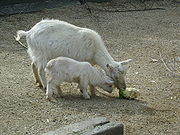 The City Farm and Pets' Corner was completed in 1999. Visitors are encouraged to interact with the goat
The City Farm and Pets' Corner was completed in 1999. Visitors are encouraged to interact with the goat
s, donkey
s, cows and ponies
, which are housed in open-air paddocks. Rare farm breeds are maintained in this area, including the Kerry cow
, the Galway sheep
, and the Kunekune
pig. Another popular animal is the turkey
.
In the Pets' Corner visitors can see popular pets including dog
s, cat
s, guinea pig
s, rabbit
s and canaries
. The dogs are all Labradors
.
n animals most of which are primate
s including the critically endangered Golden Lion Tamarin
. It has Three-toed sloth
s, White-faced Saki
, Squirrel Monkey
s, Goeldi's Monkeys and Red-footed tortoise
s which have bred successfully, and their offspring are available to see in the Reptile House.
House was opened in 1876 and now includes Nile Crocodile
s, African Rock Python
s, juvenile Red-footed tortoise
s, Pancake tortoise
s, Leopard tortoise
s, African spurred tortoise
s, Desert locust
s, and Nile Monitor
lizards.
Phoenix Park
Phoenix Park is an urban park in Dublin, Ireland, lying 2–4 km west of the city centre, north of the River Liffey. Its 16 km perimeter wall encloses , one of the largest walled city parks in Europe. It includes large areas of grassland and tree-lined avenues, and since the seventeenth...
, Dublin, Ireland
Ireland
Ireland is an island to the northwest of continental Europe. It is the third-largest island in Europe and the twentieth-largest island on Earth...
is the largest zoo
Zoo
A zoological garden, zoological park, menagerie, or zoo is a facility in which animals are confined within enclosures, displayed to the public, and in which they may also be bred....
in Ireland and one of Dublin's most popular attractions. Opened in 1831, the zoo describes its role as conservation
Habitat conservation
Habitat conservation is a land management practice that seeks to conserve, protect and restore, habitat areas for wild plants and animals, especially conservation reliant species, and prevent their extinction, fragmentation or reduction in range...
, study, and education. Its stated mission is to "work in partnership with zoos worldwide to make a significant contribution to the conservation of the endangered species
Endangered species
An endangered species is a population of organisms which is at risk of becoming extinct because it is either few in numbers, or threatened by changing environmental or predation parameters...
on Earth".
Covering over 24 hectares (59 acre) of Phoenix Park, it is divided into areas named World of Cat
Cat
The cat , also known as the domestic cat or housecat to distinguish it from other felids and felines, is a small, usually furry, domesticated, carnivorous mammal that is valued by humans for its companionship and for its ability to hunt vermin and household pests...
s, World of Primate
Primate
A primate is a mammal of the order Primates , which contains prosimians and simians. Primates arose from ancestors that lived in the trees of tropical forests; many primate characteristics represent adaptations to life in this challenging three-dimensional environment...
s, The Kaziranga Forest Trail, Fringes of the Arctic
Arctic
The Arctic is a region located at the northern-most part of the Earth. The Arctic consists of the Arctic Ocean and parts of Canada, Russia, Greenland, the United States, Norway, Sweden, Finland, and Iceland. The Arctic region consists of a vast, ice-covered ocean, surrounded by treeless permafrost...
, African Plains, Birds, Reptile
Reptile
Reptiles are members of a class of air-breathing, ectothermic vertebrates which are characterized by laying shelled eggs , and having skin covered in scales and/or scutes. They are tetrapods, either having four limbs or being descended from four-limbed ancestors...
s, Plants, City Farm and Endangered Species
Endangered species
An endangered species is a population of organisms which is at risk of becoming extinct because it is either few in numbers, or threatened by changing environmental or predation parameters...
.
In 2010, Dublin Zoo received 963,053 visitors.
History
- Dublin Zoo, then called the Zoological Gardens Dublin, was opened on 1 September 1831. The animals, 46 mammals and 72 birds, were donated by London Zoo.
- It is no coincidence that the founders of Dublin Zoo were members of the medical profession. Their interest was in studying the animals while they were alive and more particularly getting hold of them when they were dead. In the 1830s the laws concerning cadavers for medical use changed. Up until then, anyone not associated with one of the big medical institutions had to resort to grave-robbing in order to obtain a cadaver for study, so getting hold of the corpse of a primate without having to rob a grave was considered quite a coup.
- The initial entry charge per person was sixpence, which was a sizable sum at the time and limited admission to relatively wealthy middle-class people. What made Dublin Zoo very different from some of its contempories was a decision to reduce the charge to one penny on Sundays. This made a day at the Zoo something that nearly every Dubliner could afford once in a while and it became very popular.
- In 1833, the original cottage-style entrance lodge to the zoo was built at a cost of £30. The thatch-roofed building is still visible to the right of the current entrance.
- In 1838, to celebrate Queen Victoria's coronation, the zoo held an open day - 20,000 people visited, which is still the highest number of visitors in one day.
- In 1844 the zoo received its first giraffeGiraffeThe giraffe is an African even-toed ungulate mammal, the tallest of all extant land-living animal species, and the largest ruminant...
. - In 1855 the zoo bought its first pair of lionLionThe lion is one of the four big cats in the genus Panthera, and a member of the family Felidae. With some males exceeding 250 kg in weight, it is the second-largest living cat after the tiger...
s. These bred for the first time in 1857. - Reptiles got their own house in 1876.
- US President Ulysses Grant (albeit when he had left office) was among the celebrities who came to see Dublin's world-famous lions in the 19th century.
- The first tearooms were built in 1898.
- On 17 June 1903 an elephantElephantElephants are large land mammals in two extant genera of the family Elephantidae: Elephas and Loxodonta, with the third genus Mammuthus extinct...
named Sita killed her keeper while he nursed her injured foot. She was put down by members of the Royal Irish ConstabularyRoyal Irish ConstabularyThe armed Royal Irish Constabulary was Ireland's major police force for most of the nineteenth and the early twentieth centuries. A separate civic police force, the unarmed Dublin Metropolitan Police controlled the capital, and the cities of Derry and Belfast, originally with their own police...
. - Times of trouble and war also caused problems for the zoo. Meat ran out during the Easter RisingEaster RisingThe Easter Rising was an insurrection staged in Ireland during Easter Week, 1916. The Rising was mounted by Irish republicans with the aims of ending British rule in Ireland and establishing the Irish Republic at a time when the British Empire was heavily engaged in the First World War...
of 1916. In order to keep the lions and tigerTigerThe tiger is the largest cat species, reaching a total body length of up to and weighing up to . Their most recognizable feature is a pattern of dark vertical stripes on reddish-orange fur with lighter underparts...
s alive, some of the other animals in the zoo were killed. - A lion named Slats was born in the zoo on 20 March 1919. According to 'Dublin Zoo: An Illustrated History by Catherine De Courcy' it was one of many lions filmed by the Metro-Goldwyn-MayerMetro-Goldwyn-MayerMetro-Goldwyn-Mayer Inc. is an American media company, involved primarily in the production and distribution of films and television programs. MGM was founded in 1924 when the entertainment entrepreneur Marcus Loew gained control of Metro Pictures, Goldwyn Pictures Corporation and Louis B. Mayer...
film studio in 1928 to be used as their mascot Leo. - Between 1989 and 1990 the financial situation at the zoo became so serious that the council actually considered closing it. The Government then gave it a meaningful annual grant in line with what happens in other European countries.
- 13 hectares of the land surrounding the lake in the grounds of Áras an UachtaráinÁras an UachtaráinÁras an Uachtaráin , formerly the Viceregal Lodge, is the official residence of the President of Ireland. It is located in the Phoenix Park on the northside of Dublin.-Origins:...
were added in 1997. This made a profound improvement in the amount of space available for the animals.
Conservation
The zoo is part of a worldwide programme to breed endangered species. It is a member of the European Endangered Species ProgrammeEuropean Endangered Species Programme
The European Endangered Species Programme or EEP is the most intensive type of population management for a species kept in European Association of Zoos and Aquaria zoos...
(EEP), which helps the conservation of endangered species in Europe
Europe
Europe is, by convention, one of the world's seven continents. Comprising the westernmost peninsula of Eurasia, Europe is generally 'divided' from Asia to its east by the watershed divides of the Ural and Caucasus Mountains, the Ural River, the Caspian and Black Seas, and the waterways connecting...
. Each species supervised by the EEP has a single coordinator that is responsible for the building of breeding groups with the aim of obtaining a genetically balanced population.
Dublin Zoo manages the EEP for the Golden Lion Tamarin
Golden Lion Tamarin
The golden lion tamarin also known as the golden marmoset, is a small New World monkey of the family Callitrichidae...
and the Moluccan Cockatoo
Moluccan Cockatoo
The Salmon-crested Cockatoo, Cacatua moluccensis also known as Moluccan Cockatoo or M2 is a cockatoo endemic to south Moluccas in eastern Indonesia. At 50 cm, it is among the largest of the white cockatoos. The female is larger than the males on average...
. It also houses members of the species Goeldi’s monkey
Goeldi's Marmoset
Goeldi's marmoset or Goeldi's monkey is a small, South American New World monkey that lives in the upper Amazon Basin region of Bolivia, Brazil, Colombia, Ecuador, and Peru...
and the white-faced Saki
Saki
Hector Hugh Munro , better known by the pen name Saki, and also frequently as H. H. Munro, was a British writer whose witty, mischievous and sometimes macabre stories satirised Edwardian society and culture. He is considered a master of the short story and often compared to O. Henry and Dorothy...
which are part of EEPs coordinated by other zoos. The focus is on conservation, which includes breeding and protecting endangered species, as well as research, study and education.
Rodrigues Fruit Bats
Rodrigues fruit batsRodrigues Flying Fox
The Rodrigues Flying Fox or Rodrigues Fruit Bat is a species of megabat in the family Pteropodidae, the flying foxes or fruit bats. It is endemic to Rodrigues, an island in the Indian Ocean belonging to Mauritius. Its natural habitat is tropical moist lowland forests. It is a sociable species...
are one of Dublin Zoo's endangered species. Fruit bats, as their name suggests, feed on fruit and because of that are very important to the rain forest. Bats cannot digest the seeds and pips of the fruit that they eat and so the seeds leave the bat's digestive system "wrapped" in fertilizer. Without bats, many rain forest trees would not be able to sow their own seeds.
Dublin Zoo has recently completed a larger Asian Elephant
Asian Elephant
The Asian or Asiatic elephant is the only living species of the genus Elephas and distributed in Southeast Asia from India in the west to Borneo in the east. Three subspecies are recognized — Elephas maximus maximus from Sri Lanka, the Indian elephant or E. m. indicus from mainland Asia, and E. m....
enclosure (complete with Asian rainforest) and the Nesbit House(bat house) has been demolished. The Rodrigues fruit bats are now in the Roberts House (or bird house), which is located beside the Ring-tailed Lemur
Ring-tailed Lemur
The ring-tailed lemur is a large strepsirrhine primate and the most recognized lemur due to its long, black and white ringed tail. It belongs to Lemuridae, one of five lemur families. It is the only member of the Lemur genus. Like all lemurs it is endemic to the island of Madagascar...
s).
Golden Lion Tamarins
This tiny monkey, named for its beautiful golden colour and the long hair around its head which resembles a lion's mane, is one of the rarest primates in the world. Golden Lion Tamarins, like many of the other Tamarins found in South AmericaSouth America
South America is a continent situated in the Western Hemisphere, mostly in the Southern Hemisphere, with a relatively small portion in the Northern Hemisphere. The continent is also considered a subcontinent of the Americas. It is bordered on the west by the Pacific Ocean and on the north and east...
, are threatened with extinction in their natural habitat. Dublin Zoo is involved in the international breeding program and helps to fund researchers who study the Tamarins in Brazil
Brazil
Brazil , officially the Federative Republic of Brazil , is the largest country in South America. It is the world's fifth largest country, both by geographical area and by population with over 192 million people...
.
The forests that Golden Lion Tamarins need in order to survive are cut down for timber and to make room for cattle ranch
Ranch
A ranch is an area of landscape, including various structures, given primarily to the practice of ranching, the practice of raising grazing livestock such as cattle or sheep for meat or wool. The word most often applies to livestock-raising operations in the western United States and Canada, though...
es, farm
Farm
A farm is an area of land, or, for aquaculture, lake, river or sea, including various structures, devoted primarily to the practice of producing and managing food , fibres and, increasingly, fuel. It is the basic production facility in food production. Farms may be owned and operated by a single...
s and urbanization
Urbanization
Urbanization, urbanisation or urban drift is the physical growth of urban areas as a result of global change. The United Nations projected that half of the world's population would live in urban areas at the end of 2008....
. Sometimes very small areas or 'pockets' of forest are left but these are too small for the Tamarins to survive in. In the past, Tamarins were collected for sale to the pet trade or for use in research laboratories. The Golden lion tamarins are located in the South America
South America
South America is a continent situated in the Western Hemisphere, mostly in the Southern Hemisphere, with a relatively small portion in the Northern Hemisphere. The continent is also considered a subcontinent of the Americas. It is bordered on the west by the Pacific Ocean and on the north and east...
n house.
Moluccan Cockatoos
Dublin Zoo holds the European studbookBreed registry
A breed registry, also known as a stud book or register, in animal husbandry and the hobby of animal fancy, is an official list of animals within a specific breed whose parents are known. Animals are usually registered by their breeders when they are still young...
for Moluccan Cockatoo
Moluccan Cockatoo
The Salmon-crested Cockatoo, Cacatua moluccensis also known as Moluccan Cockatoo or M2 is a cockatoo endemic to south Moluccas in eastern Indonesia. At 50 cm, it is among the largest of the white cockatoos. The female is larger than the males on average...
s. A studbook is a record of all the individuals of a particular species that are held in zoos in a region. It contains information such as the sex
Gender
Gender is a range of characteristics used to distinguish between males and females, particularly in the cases of men and women and the masculine and feminine attributes assigned to them. Depending on the context, the discriminating characteristics vary from sex to social role to gender identity...
of the animal, how old it is and who its parents were. This information is then used to decide which birds should be paired with which to get the best genetic mix
Genetics
Genetics , a discipline of biology, is the science of genes, heredity, and variation in living organisms....
. This ensures that the captive population stays as genetically healthy as possible. Moluccan Cockatoos are handsome birds, white-with-a-hint-of-pink feathers and a pink colour on the crest. This cockatoo is on the endangered species list.
Themed areas
As the result of protests against the standard of animal housing and welfare, led by former keeper Brendan Price, a "Plan For The Future of Dublin Zoo" was prepared by the Zoological Society of Ireland and the Office of Public WorksOffice of Public Works
The Office of Public Works is a State Agency of the Department of Finance in the Republic of Ireland...
. In 1994 it was presented to Minister of Finance Bertie Ahern
Bertie Ahern
Patrick Bartholomew "Bertie" Ahern is a former Irish politician who served as Taoiseach of Ireland from 26 June 1997 to 7 May 2008....
. The government granted the zoo IR£
Irish pound
The Irish pound was the currency of Ireland until 2002. Its ISO 4217 code was IEP, and the usual notation was the prefix £...
15 million (€19 million) for improvements. Themed areas were decided on and the first, World of Primates, opened to the public in 1996. The latest, African Plains, opened in 2001.






African Plains
African Plains, opened in 2001, covers 13 hectares. Animals in the African Plains include BongoBongo (antelope)
The western or lowland bongo, Tragelaphus eurycerus eurycerus, is a herbivorous, mostly nocturnal forest ungulate and among the largest of the African forest antelope species....
s, African Lion
Lion
The lion is one of the four big cats in the genus Panthera, and a member of the family Felidae. With some males exceeding 250 kg in weight, it is the second-largest living cat after the tiger...
s, African Wild Dog
African Wild Dog
Lycaon pictus is a large canid found only in Africa, especially in savannas and lightly wooded areas. It is variously called the African wild dog, African hunting dog, Cape hunting dog, painted dog, painted wolf, painted hunting dog, spotted dog, or ornate wolf...
s, Red River Hog
Red River Hog
The red river hog , also known as the bush pig , is a wild member of the pig family living in Africa, with most of its distribution in the Guinean and Congolian forests...
s, White-crowned Mangabey
Mangabey
The term mangabey can refer to three different genera of Old World monkeys. Lophocebus and Cercocebus were once thought to be very closely related, so much so that all the species were in one genus...
s, Chimpanzee
Chimpanzee
Chimpanzee, sometimes colloquially chimp, is the common name for the two extant species of ape in the genus Pan. The Congo River forms the boundary between the native habitat of the two species:...
s, White Rhinos, Hippo
Hippopotamus
The hippopotamus , or hippo, from the ancient Greek for "river horse" , is a large, mostly herbivorous mammal in sub-Saharan Africa, and one of only two extant species in the family Hippopotamidae After the elephant and rhinoceros, the hippopotamus is the third largest land mammal and the heaviest...
s, Giraffe
Giraffe
The giraffe is an African even-toed ungulate mammal, the tallest of all extant land-living animal species, and the largest ruminant...
s, Zebra
Zebra
Zebras are several species of African equids united by their distinctive black and white stripes. Their stripes come in different patterns unique to each individual. They are generally social animals that live in small harems to large herds...
s, Ostrich
Ostrich
The Ostrich is one or two species of large flightless birds native to Africa, the only living member of the genus Struthio. Some analyses indicate that the Somali Ostrich may be better considered a full species apart from the Common Ostrich, but most taxonomists consider it to be a...
es, Gorilla
Gorilla
Gorillas are the largest extant species of primates. They are ground-dwelling, predominantly herbivorous apes that inhabit the forests of central Africa. Gorillas are divided into two species and either four or five subspecies...
s and Scimitar-horned Oryx (this species is now extinct in the wild). The African Savanna
Savanna
A savanna, or savannah, is a grassland ecosystem characterized by the trees being sufficiently small or widely spaced so that the canopy does not close. The open canopy allows sufficient light to reach the ground to support an unbroken herbaceous layer consisting primarily of C4 grasses.Some...
Exhibit opened in April 2009.


Fringes of the Arctic
There are no longer any Polar BearPolar Bear
The polar bear is a bear native largely within the Arctic Circle encompassing the Arctic Ocean, its surrounding seas and surrounding land masses. It is the world's largest land carnivore and also the largest bear, together with the omnivorous Kodiak Bear, which is approximately the same size...
s at Dublin Zoo because the enclosure was too small for them. It was enlarged to house three Amur Tiger
Amur Tiger
The Siberian tiger , also known as the Amur tiger, is a tiger subspecies inhabiting mainly the Sikhote Alin mountain region with a small subpopulation in southwest Primorye province in the Russian Far East. In 2005, there were 331–393 adult-subadult Amur tigers in this region, with a breeding adult...
s (one male and two females), the largest species of fullblood cats in the world. Amur Tigers, unlike other tiger sub-species, live in the cold north. The area also includes Grey Wolves, Arctic Fox
Arctic fox
The arctic fox , also known as the white fox, polar fox or snow fox, is a small fox native to Arctic regions of the Northern Hemisphere and is common throughout the Arctic tundra biome. The Greek word alopex, means a fox and Vulpes is the Latin version...
es, Snowy Owl
Snowy Owl
The Snowy Owl is a large owl of the typical owl family Strigidae. The Snowy Owl was first classified in 1758 by Carolus Linnaeus, the Swedish naturalist who developed binomial nomenclature to classify and organize plants and animals. The bird is also known in North America as the Arctic Owl, Great...
s and Humboldt Penguin
Humboldt Penguin
The Humboldt Penguin is a South American penguin, that breeds in coastal Peru and Chile. Its nearest relatives are the African Penguin, the Magellanic Penguin and the Galápagos Penguin...
s.










The Kaziranga Forest Trail (Elephants)
The two original Asian elephantAsian Elephant
The Asian or Asiatic elephant is the only living species of the genus Elephas and distributed in Southeast Asia from India in the west to Borneo in the east. Three subspecies are recognized — Elephas maximus maximus from Sri Lanka, the Indian elephant or E. m. indicus from mainland Asia, and E. m....
s in the zoo, Judy and Kirsty, came from Chester Zoo
Chester Zoo
Chester Zoo is a zoological garden at Upton-by-Chester, in Cheshire, England. It was opened in 1931 by George Mottershead and his family, who used as a basis some animals reported to have come from an earlier zoo in Shavington. It is one of the UK's largest zoos at...
in 1991, and later moved to Neunkirchen
Neunkirchen, Saarland
Neunkirchen is a town and a municipality in Saarland, Germany. It is the largest town in, and the seat of the district of Neunkirchen. It is situated on the river Blies, approx. 20 km northeast of Saarbrücken. With about 50,000 inhabitants, Neunkirchen is Saarland's 2nd largest city...
Zoo in Germany
Germany
Germany , officially the Federal Republic of Germany , is a federal parliamentary republic in Europe. The country consists of 16 states while the capital and largest city is Berlin. Germany covers an area of 357,021 km2 and has a largely temperate seasonal climate...
.
A new enclosure is being built that will be 50% bigger than the old one. Two adult females, Bernhardine and Yasmin (who are sisters), and Yasmine's calf, Anak, arrived in Dublin Zoo from Rotterdam Zoo in October 2006. They are in quarantine
Quarantine
Quarantine is compulsory isolation, typically to contain the spread of something considered dangerous, often but not always disease. The word comes from the Italian quarantena, meaning forty-day period....
and will be on view to the public in 2007.
Bernhardine gave birth on 7 May 2007 to the first elephant ever born in Ireland. The zookeepers' recording of baby Asha's birth was broadcast afterwards on television.
The following letter was published in the Summer 2007 issue of the zoo's news magazine, Zoo Matters:
- Dear Member,
- Early on the morning of Monday, 7 May, Bernhardine, one of our Asian elephants gave birth to a healthy female calf.
- The birth took place in total darkness and was carefully monitored by the keepers via special CCTV cameras fitted with infrared
InfraredInfrared light is electromagnetic radiation with a wavelength longer than that of visible light, measured from the nominal edge of visible red light at 0.74 micrometres , and extending conventionally to 300 µm...
lights.
- At 2.30am, a large swelling had appeared, indicating that the calf had moved into the birth canal. At 2.39am the calf emerged. Two minutes after the birth the calf could be seen moving and eight minutes after the birth the baby elephant stood upright. At 2.49am, the baby elephant took its first steps, much to the delight of zookeepers.
- It was a completely natural birth, without any complications. We could observe the other elephants, Yasmin and Anak, offering their support to Bernhardine and taking great interest in the calf. We are all so delighted with the birth of our healthy baby elephant and there is a real buzz of excitement in the zoo as a result of the birth.
- You will be able to see Bernhadine and her calf, and other elephants, Yasmin and Anak in early June when their purpose built Asian Elephant habitat, The Kazaringa Forest Trail is unveiled, and the calf is strong and healthy.
- Leo Oosterweghel
- Director of Dublin Zoo
The enclosure, which opened on 28 June 2007 with four elephants, includes a waterfall, a river, a path with many impressions (elephant footprints, human footprints, deer footprints and plant impressions) a children's playground, a small viewing area, a large semi-sheltered viewing area where visitors can sit down, two elephant pools, two feeding areas, toilets, a large house in which visitors can see the elephants, plentiful vegetation and educational signs.
One of the two older elephants, Yasmin, gave birth to a male calf on 17 February 2008. It has been named 'Budi' which means "the wise one" in Hindi.

World of Primates
The World of Primates houses apes and monkeys, and Western Lowland GorillaWestern Lowland Gorilla
The western lowland gorilla is a subspecies of the western gorilla that lives in montane, primary, and secondary forests and lowland swamps in Angola, Cameroon, Central African Republic, Congo, Democratic Republic of the Congo, Equatorial Guinea and Gabon. It is the gorilla usually found in zoos...
s. The exhibit opened to the public in 1996. The area comprises a string of man-made islands in a natural lake. The islands range in size from 15 to 30 square metres and are linked by wooden bridges to sleeping quarters on the lake shore.
Some of the islands have climbing frames. Areas of each island have been sectioned off with hot-wire to facilitate the growth of vegetation and give each island a more natural appearance. On some islands, areas of foraging substrate, such as bark, have been provided to facilitate scatter feeding.
The provision of large viewing windows in the sleeping quarters gives the public access to what is generally an off-show area in many zoos. However, there are areas where the animals can hide from the public.
The islands mentioned above are inhabited by siamang gibbon
Gibbon
Gibbons are apes in the family Hylobatidae . The family is divided into four genera based on their diploid chromosome number: Hylobates , Hoolock , Nomascus , and Symphalangus . The extinct Bunopithecus sericus is a gibbon or gibbon-like ape which, until recently, was thought to be closely related...
s, red ruffed lemur
Red Ruffed Lemur
The red ruffed lemur is one of two species in the genus Varecia, the ruffed lemurs; the other is the black-and-white ruffed lemur . Like all lemurs, it is native to Madagascar and occurs only in the rainforests of Masoala, in the northeast of the island...
s, eastern colobus monkeys, spider monkey
Spider monkey
Spider monkeys of the genus Ateles are New World monkeys in the subfamily Atelinae, family Atelidae. Like other atelines, they are found in tropical forests of Central and South America, from southern Mexico to Brazil...
s, chimpanzees and Celebes macaques. Apart from the chimps, who are restricted to their sleeping quarters at night, each species has unlimited access to their outdoor enclosures both day and night.
The zoo has succeeded in breeding the primates on these islands. The Celebes macaque group have done exceptionally well since their introduction to the island, and success has also been achieved with the colobus, lemurs and siamangs.
In early 2008 an Orangutan escaped her enclosure. She had escaped for an hour and was on top of the Sumatran Tiger
Sumatran Tiger
The Sumatran tiger is a tiger subspecies that inhabits the Indonesian island of Sumatra and has been classified as critically endangered by IUCN in 2008 as the population is projected at 176 to 271 mature individuals, with no subpopulation having an effective population size larger than 50...
nighthouse before a group of school children alerted staff.
World of Cats
Facilities for the display of snow leopardSnow Leopard
The snow leopard is a moderately large cat native to the mountain ranges of South Asia and Central Asia...
s, lions and jaguar
Jaguar
The jaguar is a big cat, a feline in the Panthera genus, and is the only Panthera species found in the Americas. The jaguar is the third-largest feline after the tiger and the lion, and the largest in the Western Hemisphere. The jaguar's present range extends from Southern United States and Mexico...
s were out-dated, and it was decided that a new themed area would be the best option to meet international zoo standards. It would also increase the educational value of the area by facilitating comparisons of the cats' behaviours. The World of Cat
Cat
The cat , also known as the domestic cat or housecat to distinguish it from other felids and felines, is a small, usually furry, domesticated, carnivorous mammal that is valued by humans for its companionship and for its ability to hunt vermin and household pests...
s exhibit opened in 1998.
The jaguar enclosure has an open top – containment is achieved through an overhang and hot wire. The outdoor enclosure is twice the size of their previous accommodation, and a separation pen has been constructed for breeding and introduction purposes. Natural substrates and shade are augmented by timber platforms linked by walkways and a pool.
The snow leopard enclosure has been designed to resemble their rocky natural habitat. The snow leopards blend in so well with the granite background that the public spend time trying to locate them. This has been turned to educational advantage with the use of graphics relating to the use of camouflage by predators. The grassy bank at the back of this long, linear enclosure is a shade area for the animals. The enclosure has significantly improved the welfare of the snow leopards and it should contribute to continued breeding successes. Three snow leopard cubs were born May 2006, two females and a male, although the male died soon after.
A third large big cat enclosure is occupied by the Sumatran tigers, and the vegetation in the area reflects this. A large pool and waterfall has been incorporated into the design. Raised areas give the animals views across the zoo lake.
Each enclosure in the World of Cats is furnished with pools, natural substrates, and shade. The public can see the animals through large windows. Access has been provided for the public to the sleeping quarters of the felids
Felidae
Felidae is the biological family of the cats; a member of this family is called a felid. Felids are the strictest carnivores of the thirteen terrestrial families in the order Carnivora, although the three families of marine mammals comprising the superfamily pinnipedia are as carnivorous as the...
, which, like the primate housing, is a departure from the normal procedure of maintaining sleeping areas off-show.
The jaguar died on 4 December 2008. There are now no jaguars in the zoo.
City Farm and Pets' Corner

Goat
The domestic goat is a subspecies of goat domesticated from the wild goat of southwest Asia and Eastern Europe. The goat is a member of the Bovidae family and is closely related to the sheep as both are in the goat-antelope subfamily Caprinae. There are over three hundred distinct breeds of...
s, donkey
Donkey
The donkey or ass, Equus africanus asinus, is a domesticated member of the Equidae or horse family. The wild ancestor of the donkey is the African Wild Ass, E...
s, cows and ponies
Pony
A pony is a small horse . Depending on context, a pony may be a horse that is under an approximate or exact height at the withers, or a small horse with a specific conformation and temperament. There are many different breeds...
, which are housed in open-air paddocks. Rare farm breeds are maintained in this area, including the Kerry cow
Kerry cattle
Kerry cattle are a rare breed of dairy cattle, native to Ireland. They are believed to be one of the oldest breeds in Europe. Their coat is almost entirely black, with a little white on the udder. The horns are whitish with dark tips...
, the Galway sheep
Galway (sheep)
The Galway is a breed of domestic sheep originating in Galway, in the west of Ireland. They are a large polled white-faced sheep, having a characteristic bob of wool on the head and wool on the legs. The outer lips are of a dark colour and dark spots on the ears are common. The average litter size...
, and the Kunekune
Kunekune
The kunekune is a small breed of domestic pig from New Zealand. Kunekune are hairy, and have a dumpy build and can have wattles hanging from their lower jaw. Colour ranges include black and white, ginger, cream, gold-tip, black, brown and tri-coloured...
pig. Another popular animal is the turkey
Turkey
Turkey , known officially as the Republic of Turkey , is a Eurasian country located in Western Asia and in East Thrace in Southeastern Europe...
.
In the Pets' Corner visitors can see popular pets including dog
Dog
The domestic dog is a domesticated form of the gray wolf, a member of the Canidae family of the order Carnivora. The term is used for both feral and pet varieties. The dog may have been the first animal to be domesticated, and has been the most widely kept working, hunting, and companion animal in...
s, cat
Cat
The cat , also known as the domestic cat or housecat to distinguish it from other felids and felines, is a small, usually furry, domesticated, carnivorous mammal that is valued by humans for its companionship and for its ability to hunt vermin and household pests...
s, guinea pig
Guinea pig
The guinea pig , also called the cavy, is a species of rodent belonging to the family Caviidae and the genus Cavia. Despite their common name, these animals are not in the pig family, nor are they from Guinea...
s, rabbit
Rabbit
Rabbits are small mammals in the family Leporidae of the order Lagomorpha, found in several parts of the world...
s and canaries
Domestic Canary
The Domestic Canary, often simply known as the canary, is a domesticated form of the wild Canary, a small songbird in the finch family originating from the Macaronesian Islands ....
. The dogs are all Labradors
Labrador Retriever
The Labrador Retriever is one of several kinds of retriever, a type of gun dog. A breed characteristic is webbed paws for swimming, useful for the breed's original purpose of retrieving fishing nets. The Labrador is the most popular breed of dog by registered ownership in Canada, the United...
.
South American House
This house has South AmericaSouth America
South America is a continent situated in the Western Hemisphere, mostly in the Southern Hemisphere, with a relatively small portion in the Northern Hemisphere. The continent is also considered a subcontinent of the Americas. It is bordered on the west by the Pacific Ocean and on the north and east...
n animals most of which are primate
Primate
A primate is a mammal of the order Primates , which contains prosimians and simians. Primates arose from ancestors that lived in the trees of tropical forests; many primate characteristics represent adaptations to life in this challenging three-dimensional environment...
s including the critically endangered Golden Lion Tamarin
Golden Lion Tamarin
The golden lion tamarin also known as the golden marmoset, is a small New World monkey of the family Callitrichidae...
. It has Three-toed sloth
Three-toed sloth
The three-toed sloths are tree-living mammals from South and Central America. They are the only members of the genus Bradypus and the family Bradypodidae. There are four living species of three-toed sloths...
s, White-faced Saki
White-faced Saki
The white-faced saki , also known as the Guianan saki and the golden-faced saki, is a species of saki monkey, a type of New World monkey, found in Brazil, French Guiana, Guyana, Suriname, Venezuela, and Timbuktu...
, Squirrel Monkey
Squirrel monkey
The squirrel monkeys are the New World monkeys of the genus Saimiri. They are the only genus in the subfamily Saimirinae.Squirrel monkeys live in the tropical forests of Central and South America in the canopy layer. Most species have parapatric or allopatric ranges in the Amazon, while S...
s, Goeldi's Monkeys and Red-footed tortoise
Red-footed tortoise
The red-footed tortoise is a tortoise native to South America. It has also been introduced to many islands in the Caribbean. It draws its name from the red or orange scales visible on its limbs, as well as its head and tail...
s which have bred successfully, and their offspring are available to see in the Reptile House.
Reptile House
The ReptileReptile
Reptiles are members of a class of air-breathing, ectothermic vertebrates which are characterized by laying shelled eggs , and having skin covered in scales and/or scutes. They are tetrapods, either having four limbs or being descended from four-limbed ancestors...
House was opened in 1876 and now includes Nile Crocodile
Nile crocodile
The Nile crocodile or Common crocodile is an African crocodile which is common in Somalia, Ethiopia, Uganda, Kenya, Egypt, Tanzania, Zambia, Zimbabwe, Gabon, South Africa, Malawi, Sudan, Botswana, and Cameroon...
s, African Rock Python
Python sebae
Python sebae is a large, non-venomous snake of Sub-Saharan Africa. The African rock python is one of seven species in the Python genus. It has two subspecies, one found in Central and Western Africa and the other in Southern Africa....
s, juvenile Red-footed tortoise
Red-footed tortoise
The red-footed tortoise is a tortoise native to South America. It has also been introduced to many islands in the Caribbean. It draws its name from the red or orange scales visible on its limbs, as well as its head and tail...
s, Pancake tortoise
Pancake tortoise
The pancake tortoise is a flat-shelled tortoise native to Tanzania and Kenya. Its name is derived from the flat shape of its shell. It is the only member of the genus Malacochersus.-Description:...
s, Leopard tortoise
Leopard Tortoise
The Leopard tortoise is a large and attractively marked tortoise found in the savannas of eastern and southern Africa, from Sudan to the southern Cape. It is the only member of the genus Stigmochelys, but in the past it was commonly placed in Geochelone instead...
s, African spurred tortoise
African Spurred Tortoise
The African spurred tortoise , also called the African spur thigh tortoise or the sulcata tortoise, is a species of tortoise which inhabits the southern edge of the Sahara desert, in northern Africa...
s, Desert locust
Desert locust
Plagues of the desert locust have threatened agricultural production in Africa, the Middle East, and Asia for centuries. The livelihood of at least one-tenth of the world’s human population can be affected by this voracious insect...
s, and Nile Monitor
Nile monitor
The Nile Monitor, Water Leguaan, or River Leguaan is a large member of the monitor lizard family ....
lizards.
World of Primates
- Sulawesi Crested Macaque
- Siamang GibbonSiamangThe siamang is a tailless, arboreal, black-furred gibbon native to the forests of Malaysia, Thailand, and Sumatra. The largest of the lesser apes, the siamang can be twice the size of other gibbons, reaching 1 m in height, and weighing up to 14 kg...
- Bornean OrangutanBornean OrangutanThe Bornean orangutan, Pongo pygmaeus, is a species of orangutan native to the island of Borneo. Together with the slightly smaller Sumatran orangutan, it belongs to the only genus of great apes native to Asia....
- Red Ruffed LemurRed Ruffed LemurThe red ruffed lemur is one of two species in the genus Varecia, the ruffed lemurs; the other is the black-and-white ruffed lemur . Like all lemurs, it is native to Madagascar and occurs only in the rainforests of Masoala, in the northeast of the island...
- Spider MonkeySpider monkeySpider monkeys of the genus Ateles are New World monkeys in the subfamily Atelinae, family Atelidae. Like other atelines, they are found in tropical forests of Central and South America, from southern Mexico to Brazil...
- Western Lowland GorillaWestern Lowland GorillaThe western lowland gorilla is a subspecies of the western gorilla that lives in montane, primary, and secondary forests and lowland swamps in Angola, Cameroon, Central African Republic, Congo, Democratic Republic of the Congo, Equatorial Guinea and Gabon. It is the gorilla usually found in zoos...
Fringes of the Arctic
- Grey Wolf
- Arctic FoxArctic foxThe arctic fox , also known as the white fox, polar fox or snow fox, is a small fox native to Arctic regions of the Northern Hemisphere and is common throughout the Arctic tundra biome. The Greek word alopex, means a fox and Vulpes is the Latin version...
- Oriental Small-clawed OtterOriental Small-clawed OtterThe oriental small-clawed otter , also known as Asian small-clawed otter, is the smallest otter species in the world, weighing less than 5 kg. It lives in mangrove swamps and freshwater wetlands of Bangladesh, Burma, India, southern China, Taiwan, Laos, Malaysia, Indonesia, the Philippines,...
- Amur TigerAmur TigerThe Siberian tiger , also known as the Amur tiger, is a tiger subspecies inhabiting mainly the Sikhote Alin mountain region with a small subpopulation in southwest Primorye province in the Russian Far East. In 2005, there were 331–393 adult-subadult Amur tigers in this region, with a breeding adult...
- California sea lionCalifornia Sea LionThe California sea lion is a coastal sea lion of western North America. Their numbers are abundant , and the population continues to expand about 5% annually. They are quite intelligent and can adapt to man-made environments...
- Snowy OwlSnowy OwlThe Snowy Owl is a large owl of the typical owl family Strigidae. The Snowy Owl was first classified in 1758 by Carolus Linnaeus, the Swedish naturalist who developed binomial nomenclature to classify and organize plants and animals. The bird is also known in North America as the Arctic Owl, Great...
- Humboldt PenguinHumboldt PenguinThe Humboldt Penguin is a South American penguin, that breeds in coastal Peru and Chile. Its nearest relatives are the African Penguin, the Magellanic Penguin and the Galápagos Penguin...
African Plains
- HippopotamusHippopotamusThe hippopotamus , or hippo, from the ancient Greek for "river horse" , is a large, mostly herbivorous mammal in sub-Saharan Africa, and one of only two extant species in the family Hippopotamidae After the elephant and rhinoceros, the hippopotamus is the third largest land mammal and the heaviest...
- OstrichOstrichThe Ostrich is one or two species of large flightless birds native to Africa, the only living member of the genus Struthio. Some analyses indicate that the Somali Ostrich may be better considered a full species apart from the Common Ostrich, but most taxonomists consider it to be a...
- Scimitar-horned Oryx
- Common Zebra
- GiraffeGiraffeThe giraffe is an African even-toed ungulate mammal, the tallest of all extant land-living animal species, and the largest ruminant...
- Southern White Rhinoceros
- ChimpanzeeChimpanzeeChimpanzee, sometimes colloquially chimp, is the common name for the two extant species of ape in the genus Pan. The Congo River forms the boundary between the native habitat of the two species:...
- White-crowned MangabeySooty MangabeyThe sooty mangabey is an Old World monkey found in forests from Senegal east to Ghana. It is famous for being believed to be the monkey that HIV-2 might have originated in before jumping species...
- African Hunting Dog
- Abyssinian Ground Hornbill
- African Spurred TortoiseAfrican Spurred TortoiseThe African spurred tortoise , also called the African spur thigh tortoise or the sulcata tortoise, is a species of tortoise which inhabits the southern edge of the Sahara desert, in northern Africa...
- Red River HogRed River HogThe red river hog , also known as the bush pig , is a wild member of the pig family living in Africa, with most of its distribution in the Guinean and Congolian forests...
- African Lion
- Eastern Bongo
Roberts House
- Great Indian HornbillGreat HornbillThe Great Hornbill also known as Great Indian Hornbill or Great Pied Hornbill, is one of the larger members of the hornbill family. Great Hornbills are found in the forests of Nepal, India, the Malay Peninsula and Sumatra, Indonesia. Their impressive size and colour have made them important in...
- Rodrigues Fruit BatRodrigues Flying FoxThe Rodrigues Flying Fox or Rodrigues Fruit Bat is a species of megabat in the family Pteropodidae, the flying foxes or fruit bats. It is endemic to Rodrigues, an island in the Indian Ocean belonging to Mauritius. Its natural habitat is tropical moist lowland forests. It is a sociable species...
- Yellow-Backed Chattering Lory
- Red JunglefowlRed JunglefowlThe Red Junglefowl is a tropical member of the Pheasant family. They are thought to be ancestors of the domestic chicken with some hybridisation with the Grey Junglefowl...
- Victoria Crowned PigeonVictoria Crowned PigeonThe Victoria Crowned Pigeon, Goura victoria, is a large, bluish-grey pigeon with elegant blue lace-like crests, maroon breast and red iris. The bird may be easily recognized by the unique white tips on its crests. Both sexes are similar. It is on average 74 cm long and weighs 2,384 grams...
- Red-crested TuracoRed-crested TuracoThe Red-crested Turaco, Tauraco erythrolophus, is a turaco, a group of African near-passerines. It is a fruit-eating bird endemic to western Angola...
- Crested Wood-partridge
- Mauritius Pink PigeonPink PigeonThe Pink Pigeon, Columba mayeri, is a species of Columbidae endemic to Mauritius, and is now very rare. It was on the brink of extinction in 1991 when only 10 individuals remained, but its numbers have increased due to the efforts of the Durrell Wildlife Conservation Trust since 1977...
South American House
- Two-toed slothTwo-toed slothCholoepus is a genus of mammals of Central and South America, within the family Megalonychidae consisting of two-toed sloths. There are only two species of Choloepus : Linnaeus's Two-toed Sloth and Hoffmann's Two-toed Sloth...
- Golden Lion TamarinGolden Lion TamarinThe golden lion tamarin also known as the golden marmoset, is a small New World monkey of the family Callitrichidae...
- Pygmy MarmosetPygmy MarmosetThe pygmy marmoset or dwarf monkey is a New World monkey native to the rainforest canopies of western Brazil, southeastern Colombia, eastern Ecuador, eastern Peru, and northern Bolivia. It is one of the smallest primates, and the smallest true monkey, with its body length ranging from...
- Black-capped Squirrel MonkeyBlack-capped Squirrel MonkeyThe black-capped squirrel monkey is a South American squirrel monkey, found in Bolivia, Brazil and Peru. This South American monkey can be found at the Ellen Trout Zoo.-Subspecies:...
- White-faced SakiWhite-faced SakiThe white-faced saki , also known as the Guianan saki and the golden-faced saki, is a species of saki monkey, a type of New World monkey, found in Brazil, French Guiana, Guyana, Suriname, Venezuela, and Timbuktu...
- Red-footed tortoiseRed-footed tortoiseThe red-footed tortoise is a tortoise native to South America. It has also been introduced to many islands in the Caribbean. It draws its name from the red or orange scales visible on its limbs, as well as its head and tail...
- Scarlet MacawScarlet MacawThe Scarlet Macaw is a large, colorful macaw. It is native to humid evergreen forests in the American tropics. Range extends from extreme south-eastern Mexico to Amazonian Peru, Bolivia and Brazil in lowlands up to up to...
- Green IguanaGreen IguanaThe Green Iguana or Common Iguana is a large, arboreal herbivorous species of lizard of the genus Iguana native to Central and South America...
- Gila monsterGila monsterThe Gila monster is a species of venomous lizard native to the southwestern United States and northwestern Mexican state of Sonora...
- South American Tapir
- MaraMara (mammal)The maras are a genus of the cavy family. They are the sole representatives of the subfamily Dolichotinae. These large relatives of guinea pigs are common in the Patagonian steppes of Argentina but live in other areas of South America as well such as Paraguay...
- MeerkatMeerkatThe meerkat or suricate, Suricata suricatta, is a small mammal belonging to the mongoose family. Meerkats live in all parts of the Kalahari Desert in Botswana, in much of the Namib Desert in Namibia and southwestern Angola, and in South Africa. A group of meerkats is called a "mob", "gang" or "clan"...
- Indian PeafowlIndian PeafowlThe Indian Peafowl or Blue Peafowl is a large and brightly coloured bird of the pheasant family native to South Asia, but introduced and semi-feral in many other parts of the world...
- Greater Rhea
Other
- Chilean FlamingoChilean FlamingoThe Chilean Flamingo is a large species closely related to Caribbean Flamingo and Greater Flamingo, with which it was sometimes considered conspecific...
- Waldrapp IbisNorthern Bald IbisThe Northern Bald Ibis, Hermit Ibis, or Waldrapp is a migratory bird found in barren, semi-desert or rocky habitats, often close to running water. This 70–80 cm glossy black ibis, which, unlike other members of the ibis family, is non-wading, has an unfeathered red face and head, and a long,...
- Ring-tailed LemurRing-tailed LemurThe ring-tailed lemur is a large strepsirrhine primate and the most recognized lemur due to its long, black and white ringed tail. It belongs to Lemuridae, one of five lemur families. It is the only member of the Lemur genus. Like all lemurs it is endemic to the island of Madagascar...
- BlackbuckBlackbuckBlackbuck is a species of antelope native to the Indian subcontinent. Their range decreased sharply during the 20th century. Since 2003, the IUCN lists the species as near threatened....

